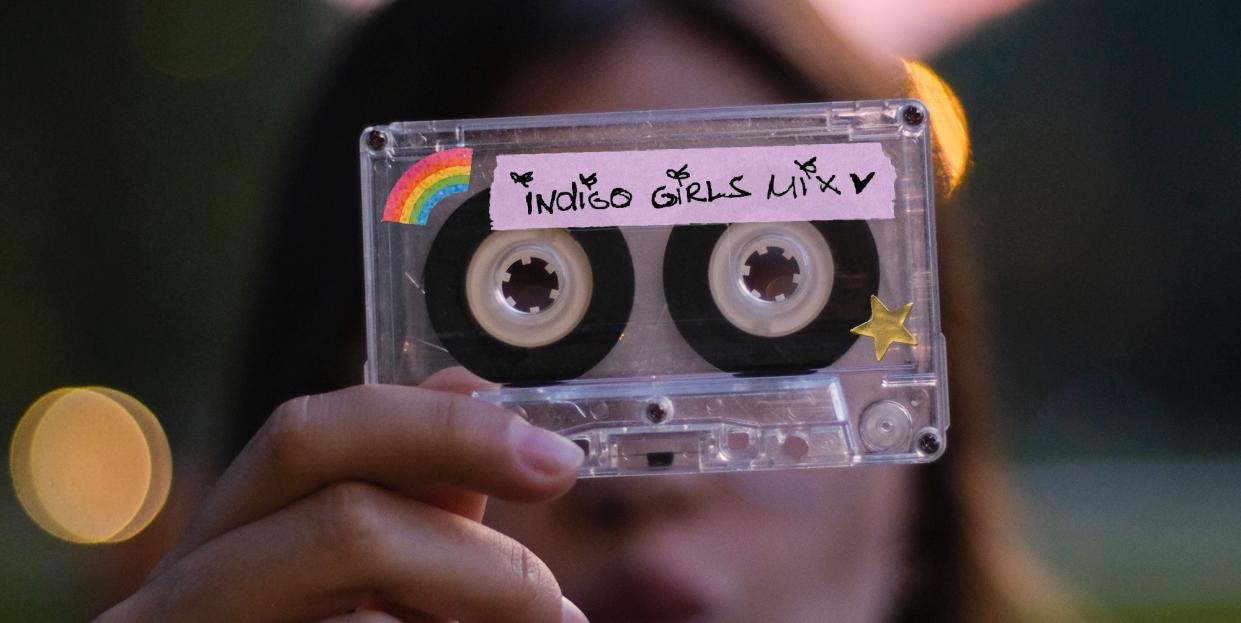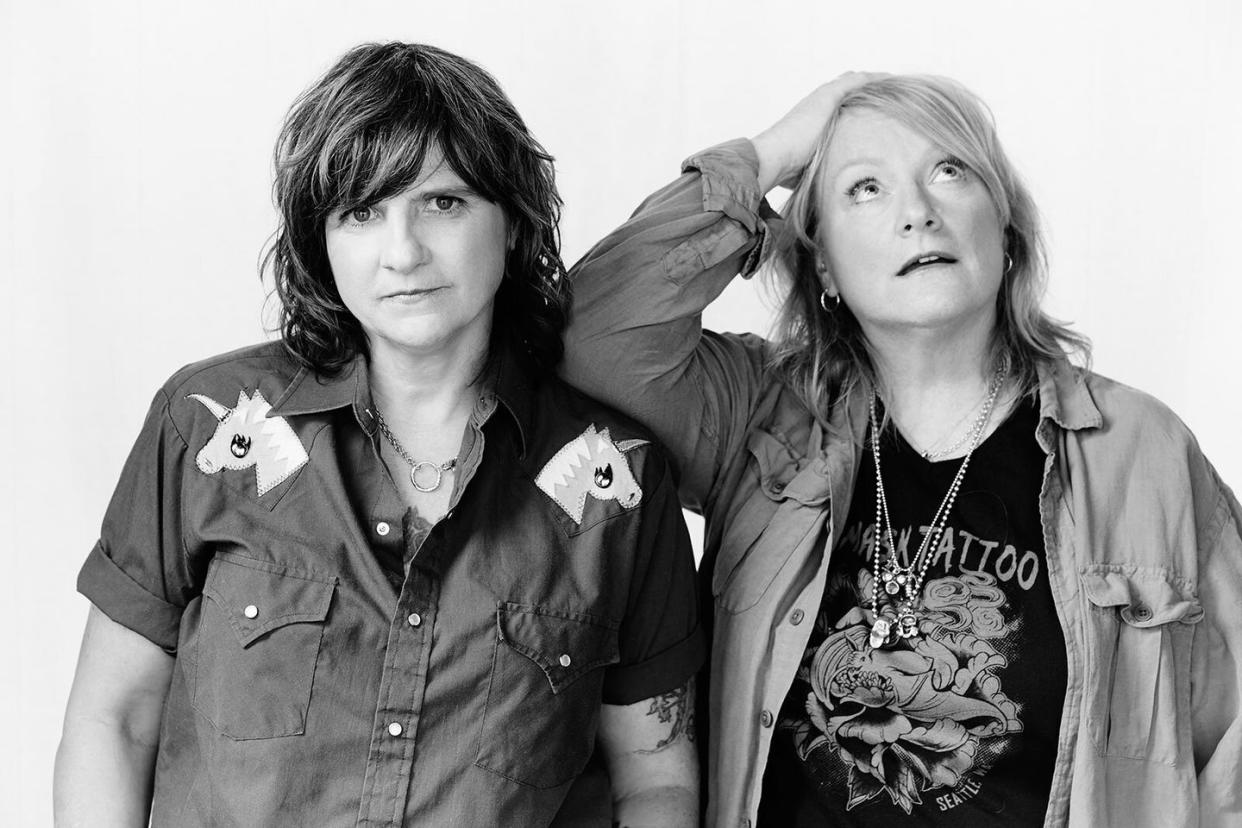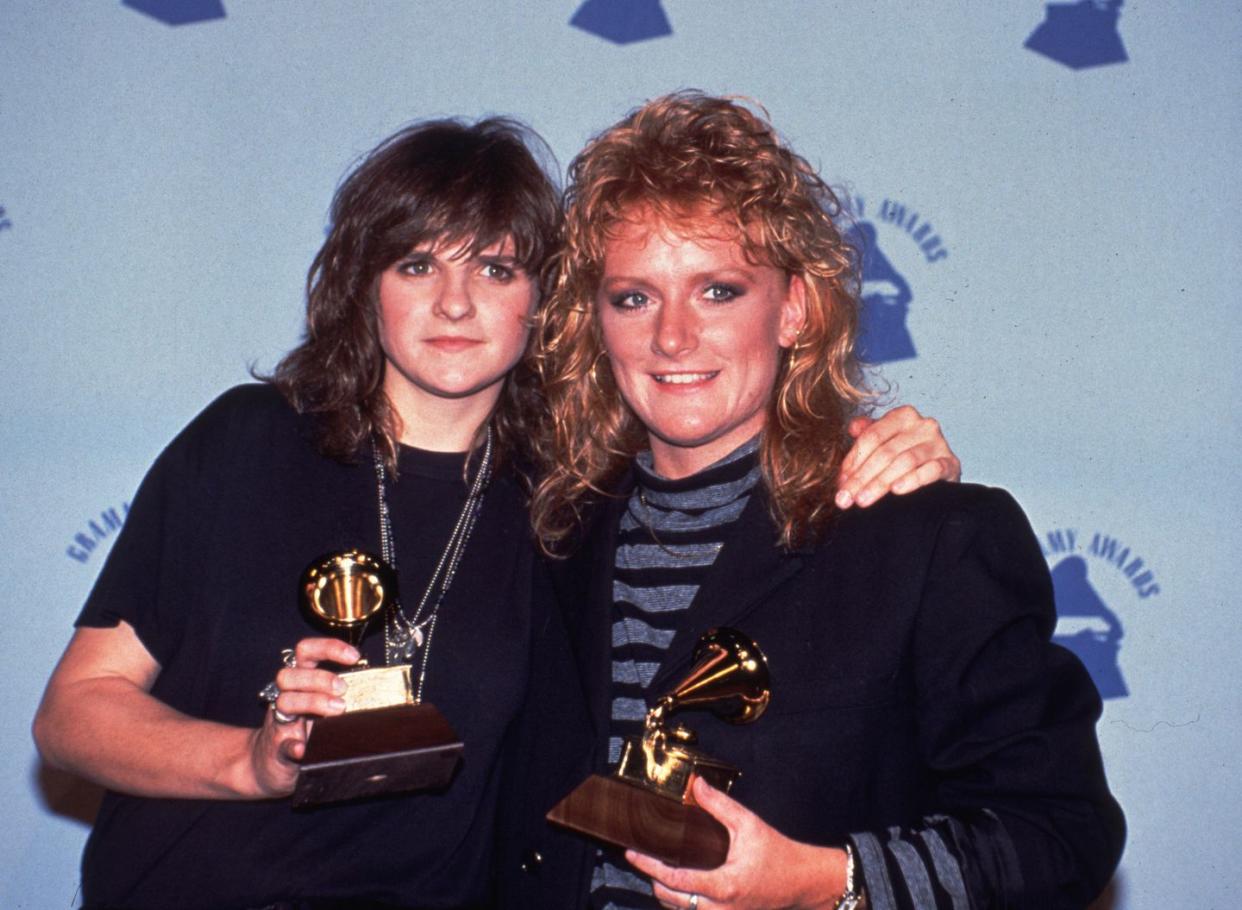The Indigo Girls Wear Prada

"Hearst Magazines and Yahoo may earn commission or revenue on some items through these links."
I sit two stories above the street. It’s awful quiet here since I’m working on a summer Friday, so I watch the Barbie trailer, like 57 million other YouTube users have. At the 58-second mark, I scream. It’s not for Margot Robbie’s pink Chanel dress, though—it’s because as she flees the confines of her tiny plastic castle, she’s belting out the vintage folk-rock hit “Closer to Fine.”
The moment brings us to a universal truth, confirmed by anyone who’s ever cried mascara tears: When a Barbie girl escapes her Barbie world, she does it shouting Indigo Girls lyrics.
“At first, I was a little bit nervous to link with Barbie,” admits Amy Ray, 59, when we speak over Zoom between tour stops. Ray and Emily Saliers, now 60, created the band in 1985 with an activist through-line of queer liberation, compassion, and shredded denim. (“I never had any Barbies as a kid,” Ray laughs. “I had GI Joe.”) But the duo was impressed with Greta Gerwig’s subversive wink of a script. “It was a big giant gift that fell out of the sky,” says Saliers. “To have a song in a major movie that’s not a drag? To get offered something that works on every level for us? When does that happen to you later in your career?”

But a lot is happening for the Indigo Girls right now.
Besides their boost from Barbie, the duo star in an acclaimed documentary from director Alexandria Bombach called It’s Only Life After All, which premiered at Sundance last January. They’re on an international tour that is selling out worldwide, getting covered by Brandi Carlile, and serving as a minor plot point in Curtis Sittenfeld’s best-selling beach read Romantic Comedy, released in April. Meanwhile, at summer camps nationwide, tweens continue to sing “Galileo” around campfires, raising arms laced in friendship bracelets they’ve tied onto one another.
“You can’t separate Indigo Girls from ’90s American girlhood,” says Katie Sturino, the Megababe founder and body activist who, quite literally, tears up saying their name. “That was the band for smart girls who knew the world was bigger than what we were offered.”
Adds TV writer Gloria Shen, 41, “I was struggling with what kind of woman I wanted to be. Their songs gave me a glimpse of it. The Indigo Girls are partners because they’re best friends, right? In their world, friendships can be even stronger than romance. For teenage girls in the ’90s, I think we always knew that, but saying it out loud was kind of revolutionary.”
And lawyer and mother Joy Nova Jones, 40, says, “They’re the first band that told me friendship is hard because it’s worth it. And romance and pain aren’t the same. We were watching movies about how you have to change who you are to fall in love,” like The Princess Diaries, Never Been Kissed, and The Breakfast Club. “Hearing life is so much bigger and richer than being someone else’s obsession—that’s not a lesson we got very often. And it’s vital.” Jones will sometimes sneak Indigo Girls classics like “The Wood Song” into her sons’ breakfast soundtrack. “They’re still very little. They don’t get how important this band is yet. But they will.”

Most women I interviewed first heard the Indigo Girls through their older sibling’s boom boxes, a babysitter’s Walkman, or a camp counselor’s talent show solo. Like Body Shop kiwi lip balm and stolen flasks of vodka, the band’s songs were passed from girl to girl in an intimate adolescent ritual that was boring and holy all at once. In the ’90s, borrowing your soccer captain’s Rites of Passage CD was itself a rite of passage.
But much like the universe, gender is expanding in faster and more beautiful ways than we can see. Can the Indigo Girls remain a beacon for peaceful and transcendent plurality, within the queer community that roots them and the larger world that flocks to them … and still be icons of girlhood?
“Yes, yes, yes!” says Ray. “We’re really proud of what we mean to girls … Our initial power came from the women’s queer community where we came up, and I can’t think about ‘girl power’ without an extension out of the heart of that. And then also, to me, there is a mysticism in the feminine; there’s an unspeakable power! Many cultures speak of prophecies of the power of women to save people … It’s a wellspring of creativity, nurturing, support, fierceness … I’ve realized that it’s been so important to be around queer community. But it is just as important to be around women, and be in the company of women. Because it’s given us everything.”
It's a sharp point coming from Ray, who speaks in the documentary about her growing awareness of gender diversity, and her own liminal place on its spectrum. “I was late to the party in a way,” she says. “But I think that might be a good thing, because I’ve gotten to experience a lot of different stuff … I fought really hard for this body I’m in, so I’m going to stay here.”
A self-proclaimed “thrift-store obsessive,” Ray finds joy in hunting down vintage menswear pieces by Vivienne Westwood and Ben Sherman, along with “all that skater stuff you’d see on your teenage nephew” from Hot Topic. (Honestly, same.) Meanwhile, Saliers prefers shirting and hats from JW Anderson, along with dream pieces from Alexander McQueen and Balmain. (“I don’t have a ton of time to shop, but do you go on the Farfetch portal? I use that.”) After a family trip to Italy, Saliers played in the same black platform Prada boots for 10 years. “I finally switched to flats, though, because at my age, I need arch support!” she laughs. “So they’re like these white astronaut sneakers. Still Prada.”
True fans know the Indigo Girls have been style influencers since the mid-’90s, when Ray appeared in a grunge concert version of Jesus Christ Superstar (as Jesus, naturally) wearing a denim look later seen on Kate Moss in the pages of Harper’s Bazaar. (The situation here is also proto-Bode.) But the band’s coolness has been constantly called into question by male rock critics high on their own thesaurus finds, and lazy SNL skits about lesbian culture. The main sticking point in both camps is the same emotional glass ceiling that women and girls crash into like birds speeding into a window: Because they center their earnestness with power and curiosity, the Indigo Girls are simply too much.
“We have struggled with that, I’ll be honest,” admits Saliers. “So many great bands are so earnest, like Rage Against the Machine … Emo bands are way more earnest than we are. But nobody’s saying that’s uncool … at the same time, we are who we are. Why be anything different? We can’t! I mean, we’ve tried!” She laughs.
“I wouldn’t change our earnestness for anything,” adds Ray. “The whole reason why we have a community and an audience to begin with, I think, is just the ability to talk from the heart, and be as honest and as transparent as possible, and care about other people, and have compassion … And now, because of women like Taylor Swift and Billie Eilish, and men being less scared of it, really, I feel like the value of earnestness in our culture is changing.”
At the apex of girlhood and earnestness lies the theater kid, an archetype that’s seen its own reevaluation over the past decade, thanks to the rise of jazz-handed cool girls like Rachel Zegler, Cynthia Erivo, Renée Rapp, Beanie Feldstein, and Molly Gordon. Meanwhile, musicals from iconic female songwriters like Sara Bareilles (Waitress), Cindy Lauper (Kinky Boots), and Alanis Morissette (Jagged Little Pill) have all hit Broadway. Could the Indigo Girls be next?
“People pitch ideas about musicals with our songs, but so far, nothing has really clicked,” Saliers says. “But if we connect with [a jukebox Indigo Girls musical] in our spirits, we will go with it.” In the meantime, she has teamed with Fun Home star Beth Malone on a sapphic retelling of Cyrano de Bergerac, tentatively called Starstruck.
“It’s the story of woman park ranger in Idaho whose dream is to bring a Dark Sky Reserve to her town,” Saliers says. “In comes this super-hot NPR podcaster, Roxane, who shakes up the town. Meanwhile, you hear all the stories of the townsfolk, what their struggles are, how they’ve all known each other since they were kids … And this woman park ranger, we learn that because of her upbringing, the deepest relationship she’s ever had is with the cosmos and the stars. Not people. But then she meets Roxane.” Saliers is also workshopping a piece called Country Radio, based on the Indigo Girls’ 2020 album Long Look, about a queer girl leaving her small-town church for Nashville, while her best friend—a Black country singer—fights for mainstream fame.
“It’s not my story,” says Saliers. “But [music] is always a little of you and a little of what you hope someone can take from you. It’s never just your story.” It’s for all girls, and the women they keep becoming.
You Might Also Like
